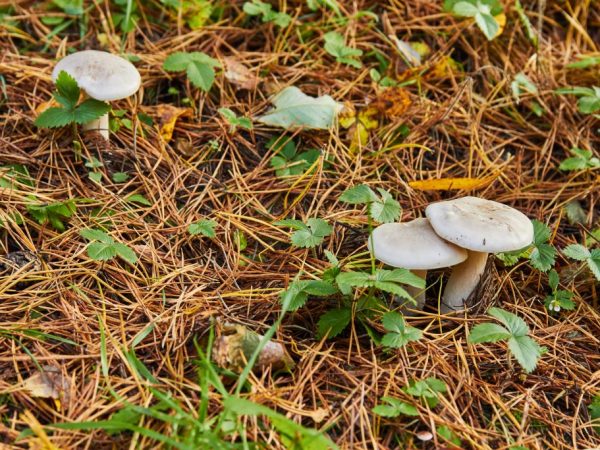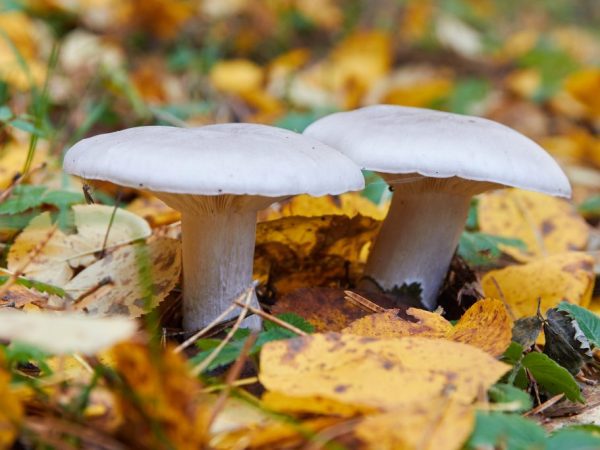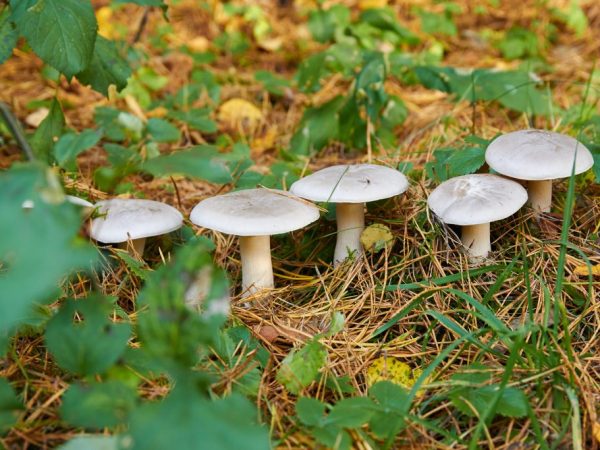Smoky talker mushroom: description
There are different types of edible and inedible mushrooms. The smoky talker is distinguished by the peculiarities of growth and development, it is represented by a large number of varieties. The study of species similar to the type of ryadovka smoky allows you to get acquainted with their characteristics and collect a large mushroom harvest.

Mushroom Smoky Talker
Description of the appearance of the mushroom
Smoky Talker Hat:
- bulging with a "hump", eventually becomes flat;
- gray;
- reaches 5-16 cm in diameter;
- hymenophore plates are white-gray;
- spore white powder.
The pulp is fruity-floral smell.
- The leg is characterized by the following qualities:
thickness 2-6 cm; - expands to the base;
- in young specimens it is fibrous-spongy inside, in old specimens it is hollow;
- the surface can be smooth or slightly wavy, colored in the tone of the cap and with a slight powdery bloom.
Irina Selyutina (Biologist):
Smoky talker belongs to the group of saprophytes, lives on soil in spruce or mixed forests, where spruce, oak and birch are always present. In addition, the species can sometimes be found in gardens, on forest edges, clearings or along paths, on forest floor, very often next to dead wood and rotting branches. By the way. Sometimes the gray ryadovka is found next to its relative - the purple ryadovka.
Its famous "floral aroma" is most active when brewed. This will be best seen on your nose if the talkers are prepared separately from other mushrooms.
Mass fruiting of this fungus, widespread in the temperate zone of the Northern Hemisphere, begins in mid-September and continues until the first decade of October. And the harvesting season begins in mid-August and ends in November.
Similar types of mushrooms
A description of the varieties related to the smoky row will be discussed below.
Waxy talker
It is a poisonous mushroom that grows in sunny places in coniferous or mixed forests from late July to late September, appears one by one or in groups.
Hat:
- convex in young specimens, depressed as it grows;
- light gray, becomes darker in wet weather;
- in the center is a small bump.
Leg description:
- smooth;
- dark white;
- wider at the bottom;
- 5 cm in height, 1 cm in diameter;
- smooth above, pubescent below.
The pulp smells bad, beige plates descending to the leg. Poison in representatives of this type of talkers can cause poisoning.
Orange talker
Other names for the species are kokoshka, false chanterelle. Representatives of the species are distributed in humid coniferous places from August to October, grow one by one or in colonies.
Hat:
- diameter 2-7 cm;
- convex, later funnel-shaped;
- yellow, after a while turns pale.
The orange talker has bright plates, almost corresponding to the color of the cap, the height of the leg is 2-7 cm, the diameter is 0.6 cm, the pulp does not smell and has no taste.Young mushroom caps are used for cooking and frying.
Giant talker

Talker fruits are edible
It grows from August to the end of October in pastures.
Hat:
- diameter 12-31 cm;
- convex, after a while - funnel-shaped;
- silky, with medium-sized scales;
- white.
Descending beige plates, leg height 9-11 cm, diameter 2-5 cm, white pulp, has a faint odor. The giant talker is boiled before eating, its fruit bodies are perfect for pickling and pickling. The pulp contains a natural compound, clithocybin A and B, which is used in the fight against tubercle bacillus.
Funnel talker
Fragrant pulp, leg height 8 cm, solid, thin. The funnel-shaped talker grows in forests, bushes, singly or in colonies from summer to autumn. The color of the cap is pale yellow or yellowish gray. By the way. Light-colored specimens of this species can resemble a poisonous whitish talker, which is fraught with negative consequences for beginners or not attentive mushroom pickers.
Hat:
- diameter 9 cm;
- tubercle in the center;
- dry and brownish yellow;
- plates are frequent, descending along the pedicle.
The mushroom is consumed at a young age and requires good boiling or drying.
Bent talker
Edible species, distributed on forest edges, calcareous soils from July to October, occurs singly or in colonies.
Hat:
- diameter 11-21 cm;
- dark yellow;
- convex, after some time takes the shape of a funnel with a tubercle in the middle.
The plates are white, yellow-pink. The leg is 11-21 cm in height, its thickness is 1-4 cm, the dry pulp has a pungent aroma.
The description of the species allows not to confuse it with a poisonous analogue - entoloma, its pulp has a rancid odor. Entoloma causes stomach upset.
Cracking talker
This poisonous mushroom grows from August to autumn in forest areas, parks, ditches.
Hat:
- diameter 4-7 cm;
- convex, later straightens;
- there is a light bloom, after cracking, clearly visible cream, red-red shades appear.
The plates are red-white, cream. The pulp is thin, without much taste. Leg height 2-6 cm, diameter 0.6-1 cm, slightly felt at the bottom.
Mace-footed talker
Representatives of this species appear from late summer to late autumn in places with birches, it is found alone or in groups.
Hat:
- convex, later flat;
- diameter up to 9 cm;
- surface color - brown.
The plates are descending, white, the flesh is thin. Leg up to 9 cm in length, gray-brown, solid, covered with bloom below. When consumed simultaneously with alcoholic beverages, the clawfoot talker is capable of provoking severe poisoning. This is a conditionally edible species, it requires compulsory boiling before frying, salting, pickling.
Beneficial features

Mushroom Improves Digestion
Ryadovka has an excellent biochemical composition:
- a lot of fiber;
- a combination of different types of protein;
- the presence of vitamins, minerals (micro and macro elements).
So, representatives of the gray talker species have a positive effect on the digestive system, affect the immune system, prevent the development of diseases, help fight the development of tumors, cleanse the human body of harmful substances and salts accumulated in the body.
Gray ryadovka refers to foods with a low amount of calories, therefore, it is excellent for dietary nutrition, vegetarians often use them due to their composition.
Talkers do not recommend eating before going to bed, it is forbidden to collect them (as well as any other edible mushrooms) near the tracks and plants due to the fact that they accumulate toxins and harmful substances in their fruit bodies.
Application
In cooking
In cooking, the caps of young specimens are used. First, they are pre-cooked and only then used in the preparation of other dishes. When cooking, it is important to take into account that this species is very much boiled down, about 5 times.
Vinaigrette with pickled talkers
For the salad you will need:
- pickled mushrooms - 150 g;
- potatoes -1-2 pcs .;
- carrots - 1 pc.;
- beets - 1 pc.;
- sauerkraut - 20-30 g;
- onion - ½;
- sunflower oil - 20 g;
- salt to taste.
All ingredients are cleaned, cut into cubes, mixed with talkers, cabbage, salt and oil are added. The salad is ready to eat, you can decorate with small whole pickled mushrooms.
Talker Caviar
For caviar you need:
- pickled mushrooms - 180 g;
- onion - 1 pc.;
- vegetable oil - 30 g;
- pepper, salt to taste.
The onion is cut and fried, the mushrooms are finely chopped and mixed with the onion, they are salted, pepper, and mixed. Caviar is eaten on its own or used as a side dish.
In medicine
Smoky talker mushroom is used in the manufacture of medicines:
- clitobicin;
- nebularin;
- diatrein and others.
What is the talker used for:
- treatment of tuberculosis, epilepsy;
- restoration, cleansing of the body;
- removal of slags, salts of heavy metals;
- antibacterial action;
- healing of wounds.
Growing methods
Smoky row is grown at home. The mycelium is sown from late spring to autumn. Wells are prepared near tree trunks at a depth of 22 cm, covered with prepared soil and mycelium is evenly placed on top of them. Next, a small layer of soil is poured and compacted. The plantings are covered with a layer of leaves, branches, moss. The wells are regularly watered. When watering, it is important to avoid both excess and lack of moisture: do not make a swamp, but also do not leave the surface dry. The first harvest will be ready a year later, talkers bear fruit under favorable conditions for 3-5 years. Productivity - 17 mushrooms per season.
The gray talker is grown at any time of the year indoors in boxes.
Conclusion
Smoky Talker is a delicious mushroom. You need to collect carefully, because there are poisonous analogues. Talkers are used in medicine and cooking, as they have useful properties.


